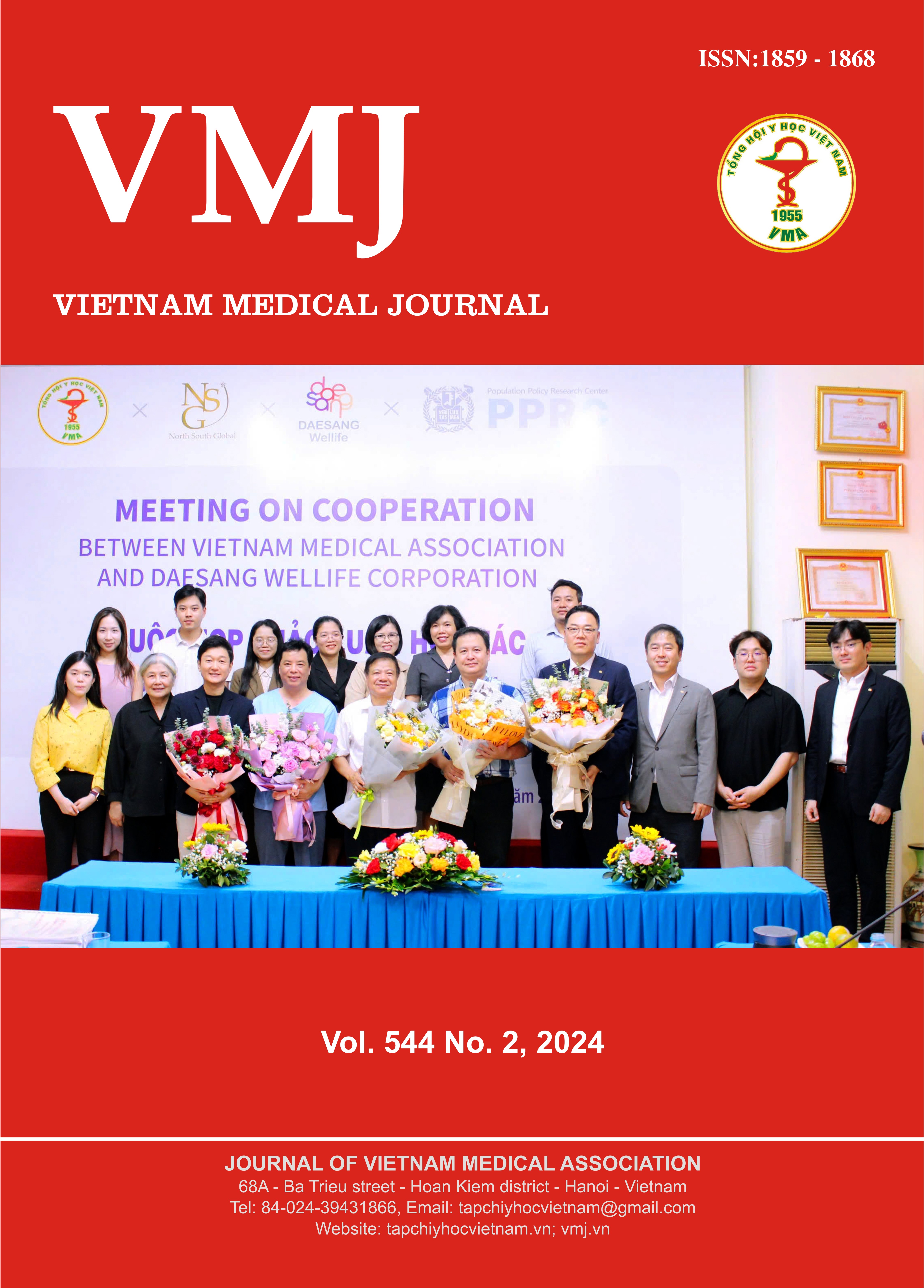SHORT-TERM TREATMENT OUTCOMES OF FORREST IIB GASTRIC AND DUODENAL ULCER BLEEDING USING HIGH-DOSE INTRAVENOUS NEXIUM
Nội dung chính của bài viết
Tóm tắt
Background: Among the causes of upper gastrointestinal bleeding, gastric and duodenal ulcers (GDU) are the most common. Forrest classification IIB (FIIB) is assessed as having a high risk of recurrent bleeding as FIA, FIB, FIIA, but treatment opinions differ. As of 2021, the European Society of Gastrointestinal Endoscopy recommends considering high-dose PPI treatment for patients in the FIIB group without endoscopic hemostasis as strong recommendation, high level of evidence. Objectives: To describe clinical and laboratory characteristics. To evaluate the short-term treatment outcomes of FIIB GDU bleeding using high-dose intravenous Nexium. Materials and methods: An uncontrolled clinical trial was conducted with 41 patients diagnosed gastrointestinal bleeding due to FIIB GDU admitted to Can Tho Central General Hospital from June 2022 to May 2024. Results: The research shows that the majority of patients responded well to treatment with high-dose intravenous Nexium (85.4%). The rates of rebleeding, surgical intervention, and mortality were relatively low at 7.3%, 2.4%, and 4.9%, respectively. Cumulative treatment failure risk was approximately 5% after 6 days of hospitalization and increased to 12.5% after 20 days of treatment. Conclusion: In patients with gastrointestinal bleeding due to FIIB peptic ulcers, treatment with high-dose intravenous Nexium has a relatively high success rate in short-term outcomes during hospitalization.
Chi tiết bài viết
Từ khóa
gastric and duodenal ulcers, Forrest IIB, high-dose intravenous Nexium
Tài liệu tham khảo
2. Lau LHS, Sung JJY (2021), “Treatment of upper gastrointestinal bleeding in 2020: New techniques and outcomes”, Dig Endosc, 33(1), pp.83-94.
3. Gralnek IM, Stanley AJ, Morris AJ, et al (2021), “Endoscopic diagnosis and management of nonvariceal upper gastrointestinal hemorrhage (NVUGIH): European Society of Gastrointestinal Endoscopy (ESGE) Guideline - Update 2021”, Endoscopy, 53(3), pp.300-332.
4. Huỳnh Hiếu Tâm (2019), Nghiên cứu hiệu quả của tiêm hoặc kẹp cầm máu qua nội soi phối hợp với thuốc ức chế bơm proton liều cao tĩnh mạch trên BN xuất huyết tiêu hóa do loét dạ dày tá tràng, Luận án Tiến sĩ Y học, Trường Đại học Y Dược Huế.
5. Sarin, N.Monga, N.Adams, P. C. (2009), "Time to endoscopy and outcomes in upper gastrointestinal bleeding", Can J Gastroenterol, 23(7), pp. 489-93.
6. Sánchez-Delgado, J.Gené, E.Suárez, D. et al (2011), "Has H. pylori prevalence in bleeding peptic ulcer been underestimated? A meta-regression", Am J Gastroenterol, 106(3), pp. 398-405.
7. Maghrebi H, Beji H, Haddad A, et al. Risk stratifying patients with non-varicosic upper gastrointestinal hemorrhage using the Glasgow-Blatchford score: A case series of 91 patients. Ann Med Surg (Lond). 2022;78:103778. Published 2022 May 13. doi:10.1016/j.amsu.2022.103778.
8. Wang J, Peng X, Ye Z, et al. Medical therapy has similar hemostatic efficacy with endoscopic treatment for PUB patients with adherent clot (FIIb ulcers). Surg Endosc. 2024;38(4):1791-1806.
9. Malik TF, Gnanapandithan K, Singh K (2023). Peptic Ulcer Disease. Treasure Island (FL): StatPearls Publishing; 2024 Jan–. PMID: 30521213.
10. Kim SH, Jung JT, Kwon JG, et al (2015), “Comparison between Endoscopic Therapy and Medical Therapy in Peptic Ulcer Patients with Adherent Clot: A Multicenter Prospective Observational Cohort Study”. Korean J Gastroenterol. 66(2), pp.98-105, doi:10.4166/kjg.2015.66.2.98.
11. ASGE STANDARDS OF PRACTICE COMMITTEE, Coelho-Prabhu N, Forbes N, et al. Adverse events associated with EGD and EGD-related techniques. Gastrointest Endosc. 2022;96(3):389-401.e1.


